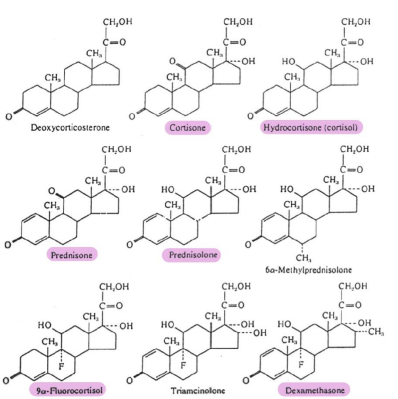Adrenal Steroids
Cortisol is a steroid hormone released from the adrenal cortex. It is involved in the stress response, gluconeogenesis, sleep-wake cycles, sodium retention, blood pressure, blood volume, and regulating inflammation.
Hypothalamic-Pituitary-Adrenal (HPA) axis
The regulatory system for many different hormones, including cortisol.
- Hypothalamus releases Corticotropin Releasing Hormone (CRH)
- CRH stimulates the Anterior Pituitary to release Adrenocorticotropic Hormone (ACTH)
- ACTH stimulates the Adrenal Cortex to release Cortisol
Hormones: [1] CRH → [2] ACTH → [3] Cortisol
Glands: [1] Hypothalamus → [2] Anterior Pituitary → [3] Adrenal Cortex
Cortisol exhibits negative feedback inhibition by signaling to both the AP and hypothalamus to decrease production of their respective hormones.
Circadian Rhythm
Cortisol levels decrease during the night, then sharply increase early in the morning.
It is important to have higher cortisol levels in the morning to have an adequate BP when we get out of bed and adequate glucose levels. Patients undergoing hormone replacement therapy or taking oral corticosteroids should administer the drug in the morning.
Glucocorticoids (GCs)
Used to treat non-endocrine disorders. They have anti-inflammatory and immunosuppressive activity. At high doses, they can also have antineoplastic (anti-tumor) effects.
Glucocorticoid: Anti-inflammatory
Mineralocorticoid: Sodium retention
Sometimes, there are used as hormone replacement therapy to treat endocrine disorders.
Common Disorders
- Asthma
- Allergies
- Arthritis
- Inflammatory Bowel Disease
- Ulcerative Colitis
- Dermatitis
- Autoimmune diseases
- Leukemia
Anti-inflammatory pathway
- GCs bind to corticosteroid binding globulin (CBG) and cross the cell membrane.
- GCs bind glucocorticoid receptor proteins, which dimerize and move to the nucleus
- GC-protein complexes can bind positive or negative GC response element (GRE)
Both positive and negative GREs reduce inflammation.
Positive GREs
Increases transcription of anti-inflammatory genes
- Lipocortin-1 protein: Blocks arachidonic acid production
- Beta-2 adrenergic receptors: Increases Beta-2 receptor density
- IL-1 receptor antagonists: Reduces immune stimulation
Negative GREs
Decreases transcription of inflammatory genes
- Cytokines/chemokines: Blocks production of cytokines (like IL-1, IL-2, IL-6, and TNF-alpha)
- COX-2: Blocks inflammatory lipid mediators
- Phospholipase A2 (PLA2): Blocks conversion of arachidonic acid to prostaglandins
- NK receptors: Inhibits NK cell activity
Management of adrenocortical disorders
Adrenal insufficiency can be either primary or secondary.
Primary adrenal insufficiency: When the adrenal glands don’t produce cortisol and sometimes also aldosterone.
Secondary adrenal insufficiency: When either the hypothalamus doesn’t produce CRH or the anterior pituitary doesn’t produce ACTH.
Cortisol deficiency is treated with oral glucocorticoid medication. If aldosterone deficiency is also present, this is supplemented with mineralocorticoids.
Addison’s Disease is a primary adrenal insufficiency.
Pharmacologic traits
By altering the steroid side chains, the activity of the molecule is altered.
- Double bond on the A-ring: Enhances glucocorticoid activity
- Methyl group at C-6: Enhances glucocorticoid activity and extends the half-life
- Fluorine at C-9: Enhances both gluco/mineralocorticoid activities
- Converting the –OH at C-11 to a ketone: Inactivates the compound
- Methyl group at C-16: Decreases mineralocorticoid activity
These characteristics can be applied to existing compounds:
- Hydrocortisone/cortisol: the -OH group means its active
- Cortisone: the ketone group means its inactive
- Prednisone: A-ring double bond means a stronger glucocorticoid while the ketone group means its inactive
- Prednisolone: A-ring double bond means a stronger glucocorticoid while the -OH group means its active
- Fludrocortisone: F group at C-9 means its potent gluco/mineralocorticoid while the -OH group means its active
- Dexamethasone: A-ring double bond means a stronger glucocorticoid while the methyl group at C-16 opposes the F at C-9, decreasing mineralocorticoid activity. The -OH group means its active

Cortisol and Prednisolone are inactivated in the kidney by 11-beta-hydroxysteroid dehydrogenase 2 (11-beta-HSD 2). As they are inactive prodrugs, they are both good topical medicaments.
Special considerations
- Pregnancy/estrogen therapy: Increases CBG levels and bound cortisol
- Sepsis and severe burns: Decreases CBG levels and bound cortisol
- Fever: Reduces CBG binding affinity, increasing free cortisol
- Black Licorice (glycyrrhetic acid): Inhibits cortisol action in kidneys, increasing sodium retention, increasing potassium secretion, increasing blood pressure and irregular heart rhythm
- Dexamethasone: Binds to albumin rather than CBG, resulting in a longer half-life and metabolism via the CYP3A4 liver enzyme
Side effects
Metabolic
- Hyperglycemia via stimulation of gluconeogenesis
- Protein loss via increased protein metabolism
- Increased fat deposits via chronic increase in glucose and subsequently insulin
Other
- Hypertension via stress response
- Osteoporosis via calcium absorption
- Infection via immunosuppression
- Peptic ulcers via inhibition of immune cells and prostaglandins
- Adrenal insufficiency
- Neurological effects (insomnia, increases appetite, mania, euphoria)
Contraindications
- Peptic ulcers
- Hypertension
- Chronic/recurrent infections
- Diabetes
- Glaucoma
- Psychosis
- Osteoporosis
Clinical pearl: Cushing's Syndrome
Chronic use of corticosteroids can lead to over production of cortisol by the adrenal glands. If a pituitary tumor is present, it causes an increase in ACTH release and therefore increased cortisol. This results in Cushing's Syndrome.